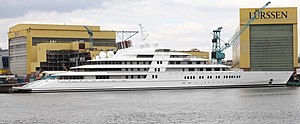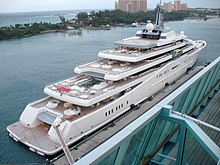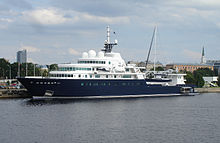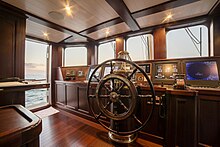

A superyacht or megayacht is a large and luxurious pleasure vessel. There are no official or agreed upon definitions for such yachts, but these terms are regularly used to describe professionally crewed motor or sailing yachts, ranging from 40 metres (130 ft) to more than 180 metres (590 ft) in length, and sometimes include yachts as small as 24 metres (79 ft).
Superyachts are often available for charter with a staff that caters to guests at a high standard of comfort. They may be designed to emphasize comfort, speed, or expedition capability. Depending on the season, superyachts may be most frequently found in the Mediterranean or the Caribbean. Many are available for charter at prices that exceed €100,000 per week. Larger examples may have more than one swimming pool; they may carry a variety of water toys, other boats, and some have helipads to receive guests from helicopters.
Characterized as symbols "of great wealth and excessive consumption", superyachts have been controversial due to their adverse environmental impact. According to one estimate, a superyacht is the single most polluting object a person can own, more so than private jets. A superyacht, large enough for a helicopter pad, submarine and a permanent crew, emits 1,500 times more carbon in a year than a typical family car.
History



At the beginning of the 20th century, when wealthy individuals constructed large private yachts for personal pleasure, some manufacturers, such as Cox & King and Charles L. Seabury and Company, were noted for their large steam yachts. The first half of the 20th century saw the first large motor yachts, including Charles Henry Fletcher's Jemima F. III (1908) at 34 metres (111 ft), Savarona (1931) at 136 metres (446 ft), and Christina O (1947 conversion) at 99 metres (325 ft).
Overview

The "Large Commercial Yacht Code (LY2)" of Great Britain and its dominions defines a "large yacht" as one that is 24 metres (79 ft) or more at the waterline and is in commercial use for sport or pleasure, while not carrying cargo or more than 12 passengers, and carrying a professional crew. The code regulates the equipping of such vessels, both at sea and in port—including such matters as crew duty times and the presence of a helicopter on board. The code has different levels of standard for vessels above and below 500 gross tons. Other countries have standards similar to LY2. Whereas yachts of 24 metres and below may be constructed of fiberglass, larger yachts are more likely to be constructed of steel, aluminum or composite fiber-reinforced plastic. Such yachts may be considered "superyachts" and are more commonly at 40 metres (130 ft) or more in length.
Whereas "commercial" large yachts may carry no more than 12 passengers, "private" yachts are solely for the pleasure of the owner and guests do not carry the passenger restriction. Yachts may be identified by flag—the country under which a yacht is registered. An industry publication categorizes superyachts by size, by speed, as "explorer" yachts, as sailing yachts, and classic yachts.
As of 2016, there were about 10,000 superyachts over 24 metres in length, worldwide. Of these about 80% were power yachts. The annual production rate was reported to be around 150. As of 2018, the 200 largest yachts ranged in length from 70 metres (230 ft) to 181 metres (594 ft)—the Azzam. The largest yacht by displacement was the 20,361 gross ton Fulk Al Salamah. At 143 metres (469 ft), the largest sail-assisted motor yacht was Sailing Yacht A. As of 2018, the top 50 sailing yachts ranged in size from 53 metres (174 ft) to 107 metres (351 ft)—the Black Pearl. The 20 fastest superyachts ranged in speed from 50 knots (93 km/h) with 7,290-horsepower (5.44 MW) engines to 67 knots (124 km/h) with 20,600-horsepower (15.4 MW) engines for the motor yacht, World is not Enough.
As superyachts have increased in size, so have the informal terms that describe their size evolved to include "megayacht", "gigayacht" and (speculatively) "terayacht".
Businesses

Between 1998 and 2008, European production of superyachts grew by 228%, ending the period with a total production of 916 units and $10 billion in orders. In January 2020, Boat International listed 4,621 professionals connected to the superyacht industry since 1856, including 1,806 builders.
Superyacht builders and yacht charter companies are predominantly based in Western Europe and the United States but are also found in Australia, New Zealand, Asia, and Eastern Europe.
Distribution

Each superyacht has a flag state where it is registered, but may have never visited. Common flag state registrars for large yachts are Cayman Islands, Marshall Islands, Isle of Man, and the British Virgin Islands, among others.
Superyachts typically frequent the Mediterranean Sea in summer and the Caribbean Sea in winter. Typical destinations in Spain and the French, Italian and Portuguese Rivieras include Cannes, Antibes, St. Tropez, Monte Carlo, Portofino, Porto Cervo, Cascais, Puerto Banús, Puerto Portals, and Palma, Mallorca; explorer superyachts may cruise in remote areas worldwide.
Charter

Some yachts are used exclusively by their private owners, others are operated all year round as charter businesses, and a large number are privately owned but available for charter part-time. As of 2018, superyacht charter costs were €70–550 thousand per week. Charter contracts usually include an advance provisioning allowance—a deposit to cover such operating expenses as food, fuel, and berthing. The unspent balance of the allowance is returned to the customer at the end of the charter.
The luxury yacht charter industry functions effectively because private yacht owners mitigate their running costs with charter income as well as keeping their yachts and crew in top running order. Conversely, private charterers charter yachts (rather than owning them) because it is generally considered to be less expensive, and less hassle, than owning a yacht and it also provides them with extra choice related to yacht type, location and crew. The vessels may do short cruises with the owners and/or guests aboard. Antigua is one of the main ports in the Windward Islands of the Caribbean and hosts a Charter Show at the beginning of the winter season.
Design and layout


The size and types of accommodations, amenities and number of water toys increases with boat size.
40 metres
A 40-metre (130 ft) superyacht may have cabins for 10–12 guests and for a crew of a similar size. This type of yacht may be configured, as follows:
- Lower deck: exterior swimming platform at the stern; four (sometimes five) guest cabins with en-suite bath aft; engine room amidships; crew quarters forward.
- Main deck: sheltered exterior deck aft leading into the saloon; dining room and galley; entrance amidships; owner's suite forward, usually includes a study, and sometimes a second stateroom for a personal assistant/bodyguard.
- Upper deck: exterior deck aft, often used for outdoor dining; second saloon (often called the sky lounge); sixth stateroom will be amidships if it is not on the lower deck or part of the owner's suite; captain's cabin; bridge.
- Sun deck: the uppermost deck, often features a hot tub and sometimes a glass-enclosed gym (which can also be below decks or even part of the owner's suite).
50 metres
A 50-metre (160 ft) yacht may have one or more yacht tenders for reaching shore and other water toys which may include a speed boat or sailing boat, personal water craft, windsurfing and diving equipment and a banana boat. Such yachts have multiple screen displays and satellite communications.
60 metres
Yachts above 60 metres (200 ft) are typically built to individual specifications, cost tens of millions of dollars, and typically have four decks above the waterline and one or two below. There is likely to be a helicopter landing platform. Apart from additional guest cabins, which are likely to include one or more "VIP suites" besides the owner's suite, such a yacht will have some or all of the following amenities: indoor hot tubs, sauna and steam rooms, a beauty salon, massage and other treatment rooms, a medical centre, a disco (usually the same space as the sky lounge or saloon, transformed into a dance area when furnishings are moved aside and special lighting activated), a cinema, plunge pool (possibly with a wave-maker), a playroom, and additional living areas such as a separate bar, secondary dining room, private sitting rooms or a library.
Support vessel

Superyachts may be accompanied by a support (or shadow) vessel that carries such items as watercraft, helicopters or other large items that the yacht itself cannot readily accommodate. Such vessels range in length from 20 to 100 metres (66 to 328 ft). There are at least four manufacturers that specialize in building such vessels. One 67-metre (220 ft) example included the following amenities: a helicopter deck, six guest rooms, two-story helicopter hangar with sound system, movie theater, freshwater pool, a landing craft, four each of: jet skis, kayaks, sailboats, diving and fishing gear, and water skis. For use ashore, there were reportedly a two-seater automobile, two motor scooters and two bicycles. The vessel also featured a 35-tonne (35,000 kg) crane.
Crew

The crew of a superyacht comprises five elements, each with its own staff: the captain, who has overall responsibility for the yacht; the chef, who is responsible for the cuisine; the interior staff, who create a hotel-like environment; the deck crew, which operates and maintains the vessel; and the engineers, who ensure the proper functioning of the vessel's many systems. A superyacht may be maintained by its crew, which may be reduced in size during the periods that the owners are not on board and no charters are booked. Most crew members live on board and are paid a monthly salary, with most living expenses covered by the owner. Live-on-board crews do not pay rent, food, electricity or water bills.
All superyachts have crew areas below deck, which consist of a crew mess, crew cabins and laundry. While most crew cabins contain bunk beds, there are captains and chief engineers who, on the larger yachts, have their own cabins. There are no set hours that crew members work each week. The hours depend greatly on how often the owners are on board, how often it is chartered and on what hours the captain sets when there are no guests on board. Crew members may be hired through crew agencies or various websites.
Environmental impacts
Superyachts have significant environmental impacts, primarily due to their substantial greenhouse gas emissions and other forms of pollution. A report by SuperYacht Times indicates that the global fleet of nearly 6,000 superyachts has expanded fourfold over the past three decades, reflecting a broader trend of wealth concentration. These vessels are predominantly powered by diesel engines. Notably, the annual CO2 emissions from just the top 300 superyachts are estimated to be nearly 285,000 tons, which surpasses the total national emissions of countries like Tonga. Beyond carbon emissions, superyachts also contribute to marine pollution through the discharge of wastewater, and by generating considerable noise and light pollution. These activities have raised significant concerns regarding their ecological footprint. These yachts typically spend less than 20% of their year under way; when in port many continue to emit CO2 from diesel-powered generators that support any guests or crew on board.
See also
- List of motor yachts by length
- List of large sailing yachts
- List of sailboat designers and manufacturers
References
- ^ "Top 200 largest yachts". Boat International. 13 December 2018. Retrieved 21 April 2019.
- ^ Nineham, Laura (22 August 2016). "Megayachts explained". Boat International. Retrieved 21 April 2019.
- Mallet, Victor (1 September 2022). "Superyachts aim to go green — but at what cost?". Financial Times.
- Niranjan, Ajit (21 November 2023). "'I cannot stress too much about it': Monaco yacht buyers shrug off climate concerns". The Guardian. ISSN 0261-3077.
- Barros, Beatriz; Wilk, Richard (2021). "The outsized carbon footprints of the super-rich". Sustainability: Science, Practice and Policy. 17 (1): 316–322. Bibcode:2021SSPP...17..316B. doi:10.1080/15487733.2021.1949847. ISSN 1548-7733.
- Ungoed-Thomas, Jon (29 January 2022). "Superyacht sales surge prompts fresh calls for curbs on their emissions". The Observer. ISSN 0029-7712.
- Day, Thomas Fleming (1916). The Rudder. Fawcett Publications. p. 252.
- Bray, Maynard (November 2000). The Book of Wooden Boats. W. W. Norton & Company. pp. 78–9. ISBN 9780393048995.
- Staff (17 July 1908), "Queen of Motor Yachts, The Jemima F. III., Largest in the World, Launched in the Harlem" (PDF), The New York Times, New York, p. 1
- "Erdoğan uses Atatürk's yacht for first time to host Bosnian leader - Turkey News". Hürriyet Daily News. 4 March 2014. Retrieved 21 April 2019.
- Overton, Holly; Lean-Vercoe, Roger; Boulton, Peter (22 November 2022). "The real story behind the Triangle of Sadness superyacht". Boat International. Retrieved 11 April 2023.
- ^ Staff (19 April 2018). "Top 50 Largest Sailing Yachts". Boat International. Retrieved 21 April 2019.
- Maritime and Coastguard Agency (September 2007). The Large Commercial Yacht Code (LY2) (PDF). Southampton: Department of Transport. Archived (PDF) from the original on 20 April 2019.
- ^ Moretti, Paolo (21 January 2015). "Yacht classification definitions". Boat International. Retrieved 19 April 2019.
- Coles, Richard; Lorenzon, Filippo (31 July 2013). Law of Yachts & Yachting. CRC Press. pp. 3–4. ISBN 9781317995791.
- ^ "Top 20 Fastest yachts". Boat International. 2018. Retrieved 21 April 2019.
- "Top 20 largest Explorer Yachts". Boat International. 2018. Retrieved 21 April 2019.
- "Top 50 Largest Sailing Yachts". Boat International. 2018. Retrieved 21 April 2019.
- "Top 20 Classic Yachts". Boat International. 2018. Retrieved 21 April 2019.
- Pearson, Oliver (29 July 2016). "Meet the New World's Largest Yacht: Superyacht 'Fulk Al Salamah'". Yacht Charter Fleet. Retrieved 11 February 2020.
- ^ Perry, Julie (August 2013). Insiders' guide to becoming a yacht stewardess : confessions from my years afloat with the rich and famous (Second ed.). New York. ISBN 978-1-61448-786-9. OCLC 859781233.
{{cite book}}: CS1 maint: location missing publisher (link) - Hoffmann, J.; Coste-Manière, I. (4 December 2012). Global Luxury Trends: Innovative Strategies for Emerging Markets. Springer. ISBN 9781137287397.
- "2008 Private Preview: Tera-Incognita". robbreport.com. October 2007.
- European Central Bank (7 February 2007). European Union Shipbuilding Industry Investment and Business Guide. Vol. 3. Washington, DC: Int'l Business Publications. p. 211. ISBN 9781433015106.
- "Search for Yachts on Boat International". Boat International. Retrieved 21 January 2020.
- ^ "Yacht Builders". Boat International. January 2020. Retrieved 20 January 2020.
- Heikell, Rod (5 August 2013). Sailing in Paradise: Yacht Charters Around the World. A&C Black. ISBN 9781408109533.
- "Top 10 flag states 2018". Lloyd's List. 10 December 2018. Retrieved 22 April 2019.
- Warren, Katie (19 April 2019). "The 10 countries with the most superyachts in the world: Ranked". Business Insider. Retrieved 22 April 2019.
- Tovey, Alan (21 April 2019). "Burgess boss Jonathan Beckett on going from 'living on rice' to selling superyachts". The Telegraph. ISSN 0307-1235. Retrieved 23 April 2019.
- "What is APA? Advance Provisioning Allowance". The MarinaReservation.com Blog - Online Marina Reservations. 11 June 2018. Retrieved 19 March 2021.
- Coles, Richard; Lorenzon, Filippo (31 July 2013). Law of Yachts & Yachting. CRC Press. ISBN 978-1-317-99578-4.
- Bestic, Ralph (22 May 2017). "5 superyachts to charter". Australian Financial Review. Melbourne: Fairfax Media. Retrieved 21 April 2019.
- Murray, Elizabeth J. (October 1998). Four Stars Afloat. Yachting. p. 44.
- ^ Williams, Michelle (25 October 2016). "Best Superyacht Design Features". Yachting Pages. Retrieved 22 April 2019.
- ^ Staff (2009). "Global Yacht for Sale Shadow Marine Motor Yacht Yacht". Superyachts.com. Retrieved 27 April 2019.
- Lardy, Kate (27 November 2017). "Me and my shadow: The rise and rise of superyacht support vessels". Boat International. Retrieved 25 April 2019.
- ^ Caswell, Chris (29 January 2015). "Who's who in a superyacht charter crew". Boat International. Retrieved 19 April 2019.
- Clarke, James (13 July 2013). Reeds Superyacht Manual. London: Adlard Coles Nautical. ISBN 9781408123034.
- Nix, Jessica (4 June 2024). "As Superyachts' Popularity Grows, So Is Their Supersized Climate Impact". www.bloomberg.com. Retrieved 4 June 2024.
Further reading
- O'Shannassy, Brendan (2022). Superyacht Captain. London: Adlard Coles. ISBN 9781472992666.